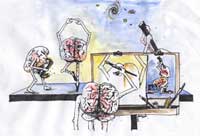Serendip is an independent site partnering with faculty at multiple colleges and universities around the world. Happy exploring!
Page 1


Welcome to the beginnings of my page. Im just learning how to do this on the new system (thanks Paul, I just got used to the old one) The intention of this site is to change continuously and provoke change, not only within, but among others as well.
Emily Dickenson
_______________________________________________________________________________________________
To The Reading/Writing "Teacher"Many of us understand that reading is a process. It is a process of taking symbols (letters) and combinations of letters (words) and assigning meaning to them. Simple...right!!!!
Before going on, I would like to make the statement that I am neither an expert on this subject or an expert on myself since I am continuously changing.
As teachers, I'm sure we have all experienced the "why can't you just do it!" frustration we have when our students "don't get it." I would like to try to use this blog as a tool for teachers (defined as educators, parents, students) to help students (defined as educators, parents, students) to understand and improve on some of the dificulties readers face.
First off, we must understand that reading is a bi-product of writing which is a bi-product of story-telling. It is a way for us to perpetuate any and all stories that people choose to tell. So the next logical question is "how do we interpret these stories?" Let's just say that it is a very complicated answer that can be summed up like this: Our brains are ALL different, so every story is interpreted differently. This is EXTREMELY important for the purposes of this Blog.
Before we beging to examin our students, let's do something many of us find to be a horrifying experience. Let's analyze our selves. Lets think about some of the difficulties we may face when it comes to reading. Decoding is the begining stages of reading. As it is defined on Misunderstood Minds, decoding is "at a basic level... recognize that letters represent the sounds of spoken words...Decoding is a foundation that children need to read quickly and fluently."
So...let's see how we can understand this with a "HANDS ON" approach. Think about how many of us tend to see and understand reading…"IT"S EASY"! But imagine if many of the concepts you already have are changed. Not dramatically, but significantly enough to change how you read and interpret certain symbols. Give it a try. Click on the link below to do the simulation. (Once you have finished, you will have to click the "BACK" button to return to this page)
Ok! So now we have some understanding as to why reading just the symbols and applying meaning to them can be difficult. Now let's apply this same concept to the next step in the reading process, comprehension. As defined on Misunderstood Minds, comprehension is the process of applying meaning to words. Then you have the final process of retention which is the ability to keep information in the brain that one aquires from the text.
But imagine that you have problems with decoding, which leads to problems with comprehension, which leads to...you guessed it...problems with retention. Click on the link below to do the simulation of comprehension and retention. (Once you have finished, you will have to click the "BACK" button to return to this page)
Now that we understand these issues facing readers, it is safe to say that the same problems can be applied to the writing process as well.
Go On to Page 2 _________________________________________________________________________________________________
To view the sources of the information, click on the link below.


